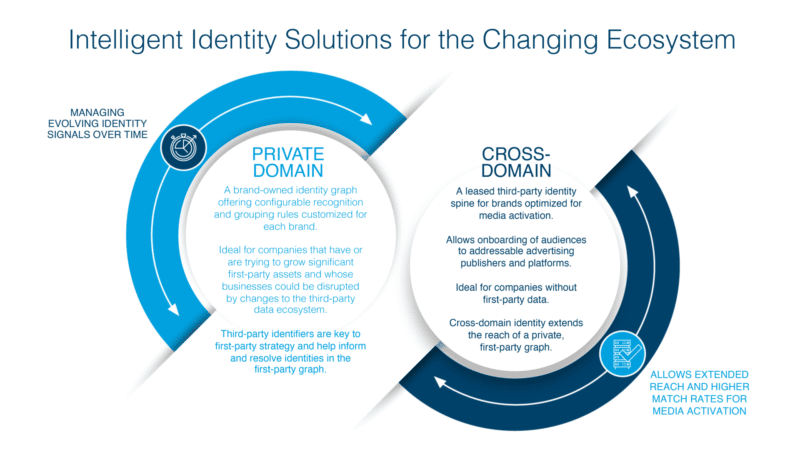
People shop in stores and on websites that recognize them and welcome them back. They like offers that match their interests and are delighted by great experiences. Sometimes they want to be fully known, at other times, they want their privacy maintained. To make this happen brands must constantly keep track of the known and pseudonymous information about people. This process requires identity. It should be the core of your madtech stack.
Top brands make sure they know who they are talking to and deliver the best possible experiences based on what they know about them. This is referred to as identity resolution, and it’s at the heart of what advertisers and marketers need to get right to deliver on their brand promise.
The art and science of identity has evolved with technological advances and the need to facilitate an incredibly complex series of decisions and actions to deliver the right content to the right person or persona – all in milliseconds. While some of this is informed by third-party cookies, the amount of information available has declined substantially and will be largely gone next year with Google no longer providing tracking information from the Chrome browser. Apple and others are already out of that business.
Google’s eventual exit has created quite the buzz about a world without third-party cookies. At Acxiom, we see the madtech world with identity at the center. From there, it’s about the process to collect, create, and convert. Trying to convert – to get a person to join, subscribe, buy or promote your brand – without the best possible fidelity around identity is difficult at best and may lead to dissatisfaction and disengagement if it goes sideways.
The path to incredible customer experience
If you start with collecting information, you’ll get both useful and distracting data. It comes from sources you know to be better – your first-party data from direct interactions with a person – like emails, loyalty programs, CRM, and mobile device IDs. This is known, or offline, identity and forms the basis for a first-party identity graph.
Acxiom helps brands focus on that private domain – meaning advertisers’ first-party data and relationships are key. The customized graph is built specifically for the advertisers’ enterprise and tailored to their specific requirements. From there, the goal is to extend that identity capability across use cases ranging from traditional direct marketing to measurement of paid media.
A lot of this hinges on the value exchange between people and brands. People want more control and transparency into how their data is being used and monetized. Brands are looking to find new high-value customers and want more transparency into how their media is working. Publishers want to monetize their content. Any intermediary that steps in between this value triangle is reducing the transparency between the primary entities.
There are powerful players in the game to collect and control information. Brands looking to control the information they can see and augment that information will be in a better position than brands counting on renting insights from third-party providers. As the walls of the “walled gardens” get higher, brands that want to market outside the closed Google or Facebook ecosystems will need a plan that puts them firmly in control of their own identity-driven solution.
Back to the path…
With identity close enough is not necessarily good enough. As communications get more personalized to smaller audience segments, advertisers are increasingly interested in who responded to which offer, which outlets performed the best, where someone is in the purchase process, and getting to know more about the consumer as they engage with the brand.
Brands, in many cases, need to know exactly who they are talking to – for example, to make a rebate offer or a firm offer of credit. Others may want to deepen the relationship with a person – starting with the first touchpoint. Correctly making these decisions counts on getting people right, knowing who they are and something about what they might want based on the signals they have collected and have access to.
And the graph.
The private identity graph is the foundation of the path to great customer experiences. This is where all the signals or noise are optimized, resolved, and enriched to build the best possible view of the customer or prospect, all while governed by the proper privacy controls.
The private graph works together with cross-domain graphs. These are graphs that are built by third-parties for the purpose of optimizing media activation and extending the reach of the private graph. This combination allows the collection, tracking, resolving, and acting on the data to happen at adtech speed. Another way to look at this is the blend of two graphs – private domain and cross domain – working together to deliver exceptional consumer experiences.

Why is this all so important?
There is more than one way to potentially achieve the same outcome. Our goal is to make sure brands put themselves in control and consider the private identity graph as the heart of the customer engagement engine. The advantages of knowing that someone is who they appear to be and resolving all the possible combinations of people who might be that person include:
- Knowing who to trust and continue to trust. This is a two-way street where the brand trusts people and can act confidently when it knows it is talking to the right person.
- Knowing that the brand is not interacting with a person acting like someone else, or even a Bot acting like a person.
- Going beyond just knowing if it’s the right device to knowing it’s the right person.
- Delivering offers to people who are entitled to the offer, like a discount for first responders or veterans.
The safest way to build on this relationship is to start with the direct relationship between one person and the brand – and grow from there. If you are the brand, think about this as what you know about a person without having to ask someone else. This is likely to be data the consumer has shared with you or that you know about them from purchase or other transactions.
Own the solution.
The madtech ecosystem is vast, complex, and constantly changing. An advertiser’s private identity graph should sit at the heart of the enterprise, acting as a central source of consumer intelligence, a brain to the nervous system that enables real-time collection, identity resolution and activation across the entire ecosystem. It’s always on, constantly collecting bits of entropy or signals from all inbound and outbound consumer engagement.
When you get identity right, everyone wins.
The post Is your brand facing an identity crisis? appeared first on Search Engine Land.
Source: IAB

